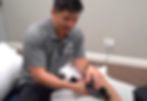
Massage guns are all the rage in the DIY/at-home health and healing community. In the last year, we've seen tons of companies develop their own versions of the massage gun. Each one claims to be the "best" because of their different amplitude or speed or attachments. To be honest, the large majority of the function pretty similarly and the "best brand" is more of a personal preference at this point. All of the ones I've tried are fairly similar in terms of how well they actually massage you.
But with their growing popularity, most people still don't completely understand why these percussive instruments even work.
Have you ever hit your knee to the point that you thought it was definitely going to bruise and your first instinct was to rub it? That's because when you rub it, you stimulate receptors to decrease pain and create an analgesic sensation. But does rubbing it really "fix" your bruised knee? Not exactly. This idea is called the Gate Control Theory by Malzack and Wall. It is this idea that CAN make massage guns completely useless.
If you're not using a massage gun correctly, you're only rubbing a bruise to make it feel better in the moment. Using it properly and being specific with what muscles your working on and for what purpose turn an expensive hammer into a great at-home healing tool.
Back in November of last year, I did an unboxing video on the Achedaway massage gun. You can watch it above! I had never used a massage gun before and really had no idea what the hype was about. Since trying it for the first time back in November, I've grown to understand and appreciate what this machine can do when used properly. Since then, I have coined the phrase "Mindful Massage Gunning", but what is that?
Using your massage gun mindfully is having an understanding of what muscles need to be RELEASED and which need to be SIMULATED or ACTIVATED. Using it in the proper direction for the proper muscle is key to seeing a long-term improvement (and not just a short-term relief).
So here are my two general rules for Mindful Massage Gunning:
If you want to release a muscle, you move from the origin of the muscle to where it inserts. Now I realize not all of you may be familiar with some of my favorite anatomy nerdy apps like 3D4medical, but a quick Google search or looking on an app such as that one can tell you where each muscle originates and where it inserts.
To tighten, strengthen or stimulate a muscle, you need to move from the insertion point to the origin!
So now that we've been over the basics, let's get to the main topic of this blog which is SHIN SPINTS.
If you feel pain or other shin splint symptoms on the inside of the shin bone, you'll want to release the posterior tibialis and gastrocnemius muscles, but stimulate the soleus. You can look at the muscle diagram below!
If you feel pain or symptoms on the outside of the shin bone, you want to release the posterior tibialis and deactivate the gastrocnemius and extensor digitorum longus muscles. Try it!

The other question I get frequently about the massage gun is which head to use. Start with the softer head before moving onto the flat and then lastly the point. You'll move from a head that distributes the percussion into something that makes it more concentrated on a single spot. This should all take about three to four minutes on each side.
If you like the massage gun I am using, you can purchase the Achedaway Massage Gun here. Use our coupon code REHABANDREVIVE for $25 OFF your purchase!
Remember, we heal smarter,
Dr. Justin C. Lin

